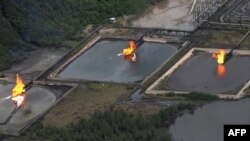Gas flares are a common sight in Nigeria’s oil-producing Niger Delta region.
But for years, there has been no way of telling who has been flaring, where it has happening, and how much natural gas has been going up in flames.
Now, there is. The Gas Flare Tracker is a website that allows governments and anyone else who is curious to see how much gas is being flared across the Niger Delta.
Using satellite data, the website displays a map showing all the gas flares in the region, with details about the gas being burned.
'Absolutely staggering'
Andrew Lewis, a technical consultant to the United Kingdom’s Department for International Development, worked on the project.
Lewis said the tracker shows how much gas is being burned that could be used to generate power in a country where reliable, round-the-clock electricity is practically non-existent.
“The gas power generation potential is absolutely staggering at ... very close to 28,000 gigawatts," Lewis said. "That would provide at least ... 40 percent of Nigeria’s total electricity requirements. It’s a very simple thing to say, it’s a shocking thing to hear, but it’s a very difficult thing to deliver.”
Minister for Environment Lawrencia Laraba-Mallam said for years Nigeria did not have data like this, and therefore did not know how much gas was being burned.
"Anytime we attend foreign conferences, you know, we hear other countries tell the amount of gas released into the atmosphere, but we guess. But from today, we will not guess, we will give the correct amount, because of this tracker," Laraba-Mallam said.
Better data could allow Nigeria to force oil companies to pay for the gas they release. By law, oil companies are supposed to pay $3.50 per million standard cubic feet of gas burned.
'Know the total number'
But Peter Idabor, director general of the National Oil Spill Detection and Response Agency, said companies skirt by without paying their fair share.
“We believe that the companies are not ... paying us accurate taxes from the volumes of gas they’re supposed to have flared," Idabor said. "You can see they gave you a table showing those amounts. But right now, we’ll be able to know the total number, the total amount of gas flared, in relation to the tax they’re paying, and then the deficit they’ll be made to pay.”
Idabor hopes more stringent enforcement of fines will encourage companies to use gas for things like power generation, rather than burning it off and releasing carbon dioxide into the atmosphere.








